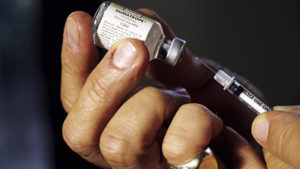
Q: What is human growth hormone?
A: Produced by the anterior pituitary gland, a pea-sized ball hanging off the brain just behind your nose, human growth hormone (HGH) is the starting point of the anabolic drive. That means – and we’re simplifying here – it travels to the liver and produces a hormone called insulin-like growth factor (IGF) which then, in tandem with exercise, testosterone and good nutrition, results in muscle growth.
Q: Do we produce different amounts at different times of our lives?
A: Yes. Its most important function has nothing to do with the quest to become Mr Olympia, rather it’s the growth of bone, cartilage, muscle and organs from birth until around age 18. Healthy adolescents produce approximately twice as much HGH as fully grown adults.
Q: Which can be frustrating for adults wanting to gain muscle…
A: Indeed so. In the 1970s, one top US bodybuilder was rumoured to have eaten monkey brains to extract the growth hormone. Until 1985, people requiring HGH treatment for medical reasons, usually because they were short in stature, were given hormones taken from recently deceased humans. That stopped when some recipients contracted mad cow disease. These days, synthetic growth hormone is the order of the day.
Q: Isn’t it illegal?
A: Correct, unless you’re prescribed it for a number of conditions, mainly concerning your pituitary’s inability to produce sufficient HGH. It’s been banned by the International Olympic Committee and most other sporting federations for some time, but proper detection, involving blood tests, has only been in place for a few years.
Q: Is it an anabolic steroid?
A: No. Steroids mimic testosterone, but chemically they aren’t exactly the same, whereas synthetic HGH does correspond to the HGH which the body produces.
Steroids can increase the size of muscle cells (hypertrophy) whereas HGH can increase the number of muscle cells (hyperplasia). Hardcore bodybuilders report that they best experience muscle growth and fat loss when they combine HGH, synthetic IGF-1 and anabolic steroids rather than take them singly.
Q: That cocktail presumably has some serious side effects…
A: Indeed. Although the evidence tends to be anecdotal rather than based on strictly conducted tests, side effects are reckoned to include irreversible thickening and growth of bones that have already reached their genetic potential, and growth of internal organs which also have already grown as much as the user’s DNA decreed. ‘Growth Hormone Gut’ is the nickname given to some bodybuilders’ distended bellies, brought about, it’s said, by the enlarging of internal organs.
Q: Is there a natural way to increase one’s own production of HGH?
A: Yes. Short bursts of intense exercise, a high protein, fairly low-carb diet, and plenty of quality deep sleep are crucial. Indeed, the majority of natural HGH is produced two hours after falling asleep. The amino acids arginine, lysine and ornithine have been shown to be beneficial, particularly amongst elderly people. The amino acid tryptophan, contained in the compound form 5-HTP, has also fared well in some studies.
If you want impressive muscle, it’s time to hit the gym like you mean it – use our tips to get into top shape 01 Maintain your […]
No time to work out? Think again – get bigger, stronger shoulders in just 15 minutes Supercharge your muscles with this high-speed workout. Combining a multi-muscle, heavyweight […]



